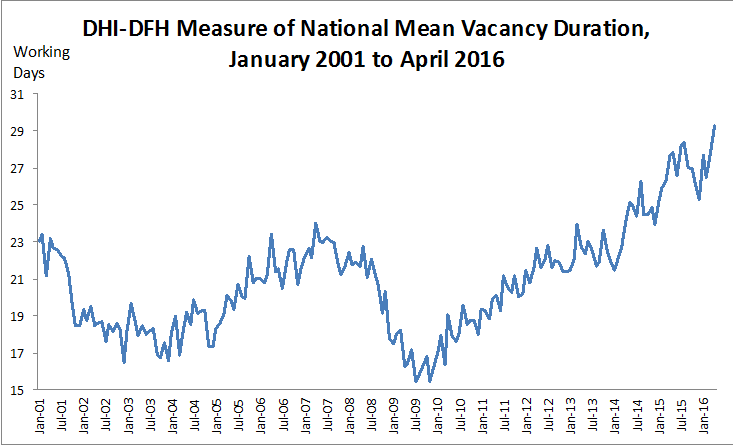It's never taken longer to fill the average job in the US
Job openings as tracked by the Bureau of Labor Statistics in the JOLTS report hit an all-time record high of 5.8 million in April 2016.
And what I suppose could be considered a kind of perfect storm for recruiting, at the same time as job openings are at a record level, the average time it takes to fill an opening has also never been higher.
Check the chart below from the latest DHI Group report, the DHI-DFH National Mean Vacancy Duration, which has been tracking average time to fill for about 15 years:

The average job now takes 29.3 working days to fill, up from 27.7 in March, and represents an all-time high time to fill for the data series.
Should you or we or anyone care about this? After all, time-to-fill as a singular recruiting metric is kind of flawed, and some would argue that it is not important at all at an individual job level.
But others (and I think I am one of them), that increasing time-to-fill duration means something, and in the aggregate, (across the entire organization or in a major job function or industry group), that it can tell you quite a bit about the effectiveness of recruiting strategies and technologies.
Because for me, when thinking about the massive amounts of investments made in technologies that are designed (at least on paper), to make recruiting, (again, in the aggregate), more efficient and effective, this all-time high level for time to fill suggests that we are all contributing in some degree to a pretty massive fail. What other industry or major business process can you think of that has actually gotten less efficient, despite hundreds of millions of dollars of investment over more than two decades?
Again, I know time-to-fill taken by itself and out of context might not be the best way to judge the health and success of technological investments for recruiting, but I think even the most cynical would have to at least admit that at a macro level that time-to-fill should not be increasing to all-time highs if organizations and their technology partners were actually functioning as designed or promised.
Shouldn't recruiting be getting easier? Even just a little easier?
I'd love to know what you think.
Am I off-base to even be thinking that time-to-fill really matters? Most organizations would happily trade a few days to fill in order to make the 'right' hire. But shouldn't technology and process have evolved to the point where making that tradeoff should happen less and less?
This issue was on my mind way before this latest set of statistics has come out, and I am even putting together a general session at the upcoming HR Technology Conference in October to talk about it.
Two decades, millions and millions of dollars spent, and yet at least by this measure, we are not getting any better at putting people in the right jobs.
It's baffling to me.

 Steve
Steve
Reader Comments